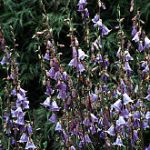| Common Name: |
Fickle Ladybell |
| Botanical Name: |
Adenophora stricta |
| Genus: |
Adenophora |
| Family: |
Campanulaceae |
| Location: |
E Asia |
| Cultivation: |
Grow in light, rich, well-drained, moist soil in sun or in partial shade. Plant out when young, since established specimens are deep-rooted and resent disturbance. Adenophora may become invasive. |
| Propagation: |
By seed sown in autumn; by basal cuttings in early spring. Adenophora does not divide well. |
| Harvest: |
Roots are lifted in autumn and dried for use in decoctions. |
| Height: |
60-90cm (24-36in) |
| Width: |
30cm (12in) |
| Hardiness: |
Z4-8 |
| Parts Used: |
Roots (nan sha shen) |
| Properties: |
A stimulant herb that acts mainly on the respiratory system and heart. |
| Medicinal Uses: |
Internally for dry coughs, chronic bronchitis, and tuberculosis. |
| Bibliography: |
Encyclopedia of Herbs by Deni BrownCopyright © 1995, 2001 Dorling Kindersley Limited. pp. 102-103 |

